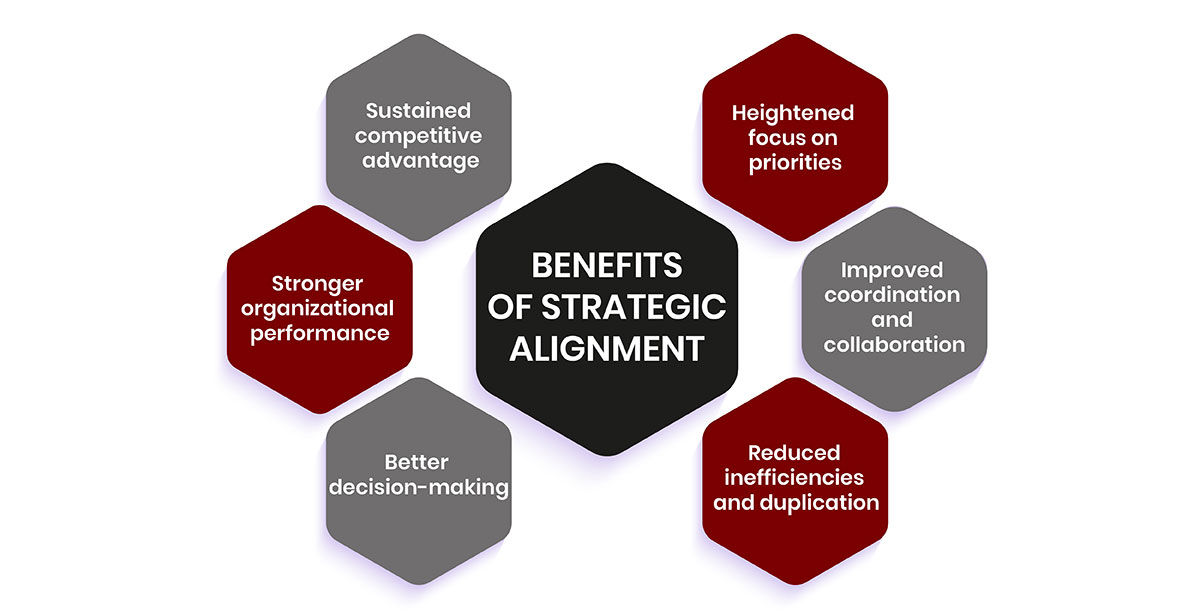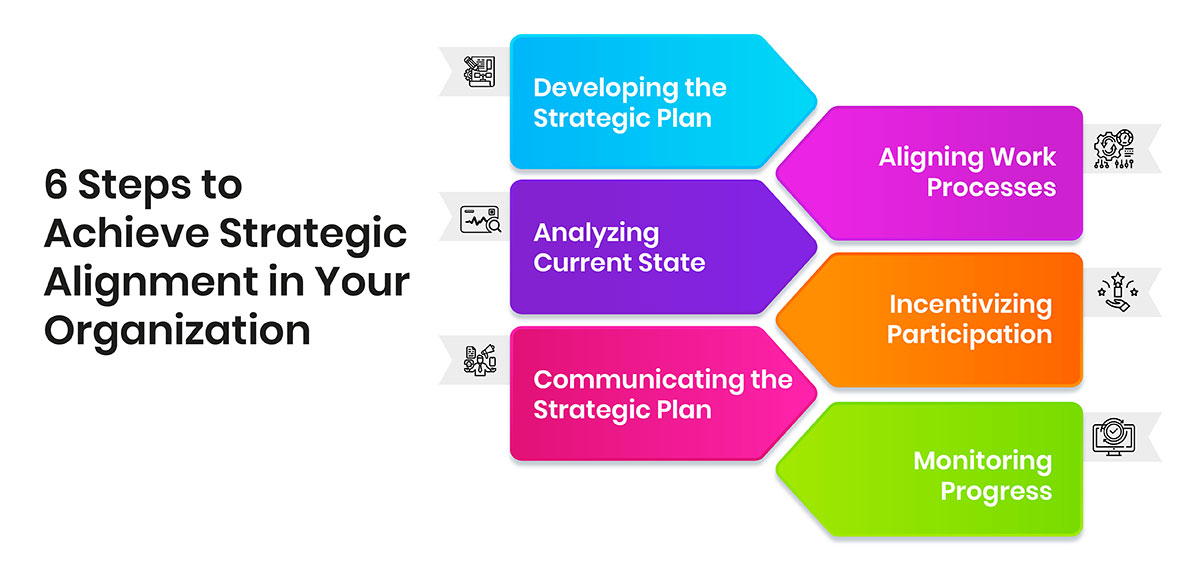A Complete Guide to Achieve Strategic Alignment in Your Organization
 August 27, 2024
August 27, 2024
Strategic alignment refers to integrating an organization's goals into its strategies, objectives, and work processes so that everyone is jointly working towards achieving the stated business goals. When implemented effectively across all departments and team levels, it ensures that the organization functions as a cohesive unit with a unified direction and purpose.
This article will explore the concept of strategic alignment in detail and provide a framework for businesses to implement it successfully. It will cover:
-
What is strategic alignment and why is it important?
-
Components of an effective strategic plan
-
Steps to analyze organizational goals and strategies
-
Communicating the strategic plan organization-wide
-
Aligning work processes and incentivizing participation
-
Monitoring progress and making adjustments
What is Strategic Alignment?
Strategic alignment is the practice of integrating an organization's goals and strategic objectives into its overall business strategy, work processes, and individual roles. It refers to getting every member of the organization - from top-level management to frontline employees - working seamlessly towards a shared vision.
When done effectively, strategic alignment results in greater coordination, stronger collaboration, and optimal use of resources to achieve organizational goals. It prevents fragmented efforts across departments and helps improve performance. The actions of each strategic business unit, team and individual directly contribute to and drive the organization's overall success.
Why is Strategic Alignment Important?
While having a clearly defined business strategy is important, it is of little use if the organization is not aligned around it. Strategic alignment is crucial because it ensures the day-to-day work and the efforts of all employees are systematically contributing towards the long-term objectives.
Some key benefits of strategic alignment include:

-
Heightened focus on priorities: Resources and efforts get consolidated around initiatives that create maximum value. Low-priority or non-strategic work gets eliminated.
-
Improved coordination and collaboration: Functional silos are broken as everyone sees themselves as working for the organization rather than just their department or team.
-
Reduced inefficiencies and duplication: Processes, systems and structures are designed to optimize cross-functional cooperation rather than operate independently.
-
Better decision-making: Executives and managers can make informed choices regarding investments, opportunities and challenges as they have visibility into their impact on strategic objectives.
-
Stronger organizational performance: Synergies are created when diverse skills and perspectives across levels work as one united force towards common goals.
-
Sustained competitive advantage: Continuous innovation and improvements help the organization stay agile and resilient through changes in the business environment.
So in essence, strategic alignment acts like a strategic GPS - it orients the entire organization in the right strategic direction to achieve its vision.
Steps to Analyze Organizational Goals and Strategies
To analyze your organization's goals and strategies, there is a clear process you should follow. Understanding where you want to go is the first step, and these methods will help you do that effectively.
-
Understand the Mission and Vision
The first step is to clearly understand the company's mission and vision. The mission statement describes what the organization does and who it serves. The vision statement outlines where the organization wants to be in the future. It's important to review these public statements and any internal documents that provide more depth on the long-term goals and direction of the company.
-
Meet with Leadership
To gain a more comprehensive understanding, schedule meetings with leaders, managers, and other key stakeholders within the company. Prepare thoughtful questions to learn about short-, medium-, and long-term goals. Ask how policies on social responsibility and other strategic matters relate to the overall goals. Meeting directly with knowledgeable individuals provides valuable insights beyond published statements.
-
Analyze Strategic Documents
Thoroughly review all relevant strategic documents, plans, reports, and materials. This includes analyzing the company's current strategies and how they connect and contribute to goals. Look for any gaps between stated goals and actual strategies. Consolidate the key information found to develop a cohesive overview of the organizational goals and direction.
-
Assess Departmental Alignment
With a clear picture of corporate goals and strategies, examine specific departments to evaluate alignment. Determine if departmental objectives effectively support and work towards achieving overarching aims. Are certain roles or processes inconsistent or need redefining? Analyzing department alignment highlights areas needing improvement to optimize contribution to goals.
-
Evaluate Performance Metrics
Successful goal achievement requires measurable targets. Identify existing metrics and key performance indicators used to track progress. Determine if metrics provide a full picture of goal progress or if additional metrics need development. Regular metric analysis allows ongoing assessment of strategies and redirects where needed.
-
Continuous Assessment
Organizational goals and business conditions are constantly evolving. Maintain an open feedback process and periodically reevaluate goals, strategies and performance. Look for disconnects that emerge over time. Be prepared to update documentation, objectives and metrics as understanding deepens or circumstances change. Continuous assessment guarantees ongoing strategic alignment.
This process keeps the organization focused and coordinated to make consistent progress towards its long-term aims. But how exactly can an organization implement effective strategic alignment?
Steps to Achieve Strategic Alignment in Your Organization
The following are the steps to achieve strategic alignment in your organization:

1. Developing the Strategic Plan
The first step towards achieving strategic alignment is to develop a robust strategic plan. A high-quality strategic plan forms the backbone of the organization's strategy and goals. Some key elements to include in the plan are:
-
Vision and Mission Statements: These clearly articulate the organization's purpose of existence and desired future state. The vision should be aspirational while the mission outlines how the vision will be achieved.
-
SWOT Analysis: A thorough internal and external assessment of strengths, weaknesses, opportunities and threats facing the organization. This provides a realistic starting point.
-
Critical Success Factors: The few essential things that must go really well for the organization to thrive over the next 3 to 5 years. These are carefully identified based on the SWOT.
-
Financial and Non-Financial Goals: Quantifiable multi-year objectives for growth, profitability, market share, customer loyalty, employee engagement etc. aligned to the CSFs(Critical Success Factors).
-
Functional/Departmental Objectives: Specific and measurable sub-goals for each department/division aligned to the organizational goals.
-
Key Performance Indicators: Metrics to track and evaluate progress towards goals across departments and individuals on a periodic basis.
-
Major Strategic Initiatives: High-impact projects and programs that will help accomplish the goals within set timelines and budgets.
The strategic plan needs to be comprehensive yet concise and clearly communicated. It forms the base for ongoing strategic decision-making, resource allocation and performance management.
2. Analyzing Current State
Before implementing the strategic plan, it is imperative to closely analyze the organization's current state with respect to the plan. This involves:
-
Evaluating the existing business model, policies, structures and workflows
-
Assessing performance gaps through division/department-level scorecards
-
Identifying work processes and roles not adequately driving strategy
-
Understanding blockers faced by teams/employees to achieve targets
-
Prioritizing areas requiring urgent alignment
Metrics like productivity, quality, cycle time, and customer satisfaction, yield invaluable ground-level insights. Interviews and focus groups further uncover informal processes, bottlenecks, pain points etc. The learnings help optimize the strategic plan accordingly.
3. Communicating the Strategic Plan
Once finalized, it is critical to communicate the strategic plan organization-wide to enable collaborative execution. Multiple channels should be used such as:
-
Email briefs, presentations, and webinars to disseminate key elements
-
Discussions at all-team/departmental meetings facilitated by leaders
-
Publishing visual strategy maps and scorecards for transparency
-
Incorporating plan highlights into new employee onboarding
-
Distributing periodic newsletters tracking progress
-
Adding strategy elements as performance objectives for managers
Interactive sessions clear misconceptions and boost buy-in. Regular refresher programs keep strategy top-of-mind as priorities change over time. Consistent communication fosters psychological ownership essential for alignment.
4. Aligning Work Processes
Post-strategy communication, existing structures and processes need alignment with the strategic plan through:
-
Adjusting departmental charters, workflows and KRAs as needed
-
Redesigning jobs, designating breakthrough priorities for roles
-
Empowering cross-functional collaboration through policies
-
Promoting agility via workflows responsive to dynamic goals
-
Linking systems and tools to core strategic and operational KPIs
-
Enabling rapid decision-making through streamlined approval mechanisms
-
Updating budgets, targets and review cycles of departments/teams
-
Reskilling/hiring to gain capabilities vital to strategy execution
-
Linking performance reviews and incentives to goal achievement
-
Recognizing and rewarding goal-aligned, high-impact initiatives
This helps reshape day-to-day activities to organizational strategic needs. Changes need to be managed sensitively and reinforced through support.
5. Incentivizing Participation
Active employee participation is required for embedding strategic alignment into organizational culture. Strategic plan execution should be a collective team effort, not the responsibility of a few candidates. Organizations can motivate proactive participation through:
-
Strategy communication and commitment reinforcement programs
-
Goal cascading tied to transparent goal setting at all levels
-
Recognizing teams/individuals demonstrating exemplary alignment
-
Providing learning/upskilling opportunities linked to priorities
-
Introducing gamification elements for healthy strategy-aligned competition
-
Surveying engagement and addressing popular issues/concerns quickly
-
Rewarding innovative ideas co-created to enhance goal accomplishment
Intrinsic and subtle extrinsic motivators keep strategic focus salient, encourage ownership and foster collective problem-solving.
6. Monitoring Progress
Finally, to sustain strategic alignment, continuous progress monitoring and adjustments are vital:
-
Holding periodic KPI performance reviews across functions/divisions
-
Conducting gap analysis vis-a-vis strategies, goals and budgets
-
Revisiting strategy rhythmically for changes or unplanned opportunities
-
Updating strategic initiatives promptly in response to shifts
-
Addressing emerging risks or new pain points hindering efforts
-
Facilitating regular check-ins for strategy progress updates
-
Gathering frequent qualitative employee sentiment feedback
-
Benchmarking against strategies and results of industry leaders
Adjusting plans helps in making good decisions in a changing environment. Regular reviews and solving problems on time increase trust and make everyone feel more committed to the strategy.
Wrapping Up
In conclusion, strategic alignment optimizes organizational success by fostering exceptional teamwork towards shared objectives. It requires meticulous planning, organization-wide coordination and dedicated change management to instil strategy into daily work processes and culture. Periodic monitoring then helps refine strategic alignment for ongoing business growth and success.



